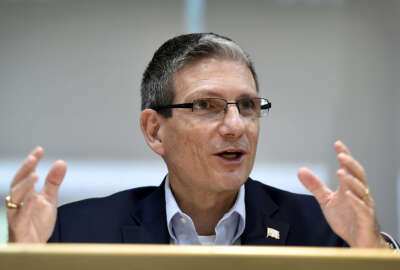One year later, commission’s proposals for improving military, public service may get a serious look
The congressionally-chartered National Commission on Military, National and Public Service made 124 recommendations last year, right at the start of the pandemic.
Timing hasn’t always been right for the congressionally-chartered National Commission on Military, National and Public Service.
It released an interim report during the longest government shutdown in U.S. history.
A final report with 124 recommendations came nearly a year ago, at the height of the pandemic.
The recommendations received little attention from Congress at the time, though the Senate Homeland Security and Governmental Affairs Committee did discuss them at a hearing last summer.
The commission made an urgent plea to Congress and the president at the time. But the committee with the broadest authority to act on those recommendations never considered them in a public forum, and the commission formally disbanded last year.
“The committee had to postpone this scheduled hearing due to the pandemic,” Jack Reed (D-R.I.), chairman of the Senate Armed Services Committee, said Thursday at a hearing on the commission’s year-old recommendations. “This past year has underscored the importance of a shared commitment to the public good, and the commission’s recommendations resonate even more strongly today.”
Congress never seriously considered the commission’s recommendations for the purposes of enacting them in legislation. But that could change, now that the Senate Armed Services Committee is engaged and beginning to consider what it might tackle in next year’s annual defense authorization bill.
“The ideas and analysis you put forward I can assure you will be carefully reviewed and we hope, in large part, incorporated into the next national defense bill after appropriate review and debate,” Reed said.
Congress tasked an 11-member commission to review the military selective service process and find ways to improve and increase public participation in national and public service programs. The commission spent two-and-a-half years doing research, holding town halls and discussions in 22 states and collecting nearly 4,300 public comments.
The Senate Armed Services Committee is most interested in improving the selective service, which the commission recommends preserving and expanding to include women.
There are 32 million 17-to-24-year-olds in the United States each year, but just 9 million meet the current physical fitness and legal standards required to serve in the military.
About 4.5 million of those Americans are academically qualified for military service, and just 10%, or 450,000, are interested and potentially willing to serve, said Joe Heck, chairman of the commission.
The commission acknowledged it heard opposition to its recommendations, particularly in including women in the selective service.
Roughly 29% of men and 29.3% of women currently meet initial standards required to serve in the military, the commission found.
“If [they]re were called to register and potentially considered for a draft, both men and women would be equally qualified to meet the current accession standards,” said Debra Wada, the commission’s vice chairman on military service.
With relatively few Americans interested and qualified in active-duty service, the commission suggested Congress and the executive branch find ways to link military, national and public service opportunities together.
Young people who are, for example, ineligible for active-duty military service, should be encouraged and given the tools to apply for a position in the federal government or a program like AmeriCorps.
The government should create a one-stop-shop that describes all these of the opportunities, the commission said.
“You can’t be what you don’t know. We have to make sure that people are aware of the opportunities that are out there for them,” Heck said. “Once they are aware they need to aspire to want to participate, and then we have to make sure they have a program. We feel that one of the best ways to do that is to create an online platform, kind of a national service clearinghouse, where all forms of service are there — military, national and public service — that outline what the responsibilities are and what the benefits are.”
In some situations, the commission set specific recruitment targets for national and public service programs.
It recommended, for example, having 1 million people participate in national service programs, such as AmeriCops, by 2031. Just 75,000 people participate in AmeriCorps each year today.
The federal government, the commission said, should set a goal of hiring 30,000 students and recent graduates each year. That target is well above the current reality. New hires of student interns fell from roughly 35,000 in 2010 to 4,000 in 2018.
In addition, the commission recommended the creation of an Individual Ready Reserve (IRR), which would allow individuals with critical skills, especially those with tech and cyber expertise, to volunteer for military service.
“Certain moments in our country’s history have galvanized generations and called them to serve,” Sen. Mark Kelly (D-Ariz.) said. “Sept. 11 is an example of this. There have been others, and that’s sometimes military service. It’s sometimes other forms of federal service. Then there are other events. Events like the SolarWinds hack … remind us how important certain critical skill areas will continue to be for our government.”
Copyright © 2025 Federal News Network. All rights reserved. This website is not intended for users located within the European Economic Area.
Nicole Ogrysko is a reporter for Federal News Network focusing on the federal workforce and federal pay and benefits.
Follow @nogryskoWFED
Related Stories





